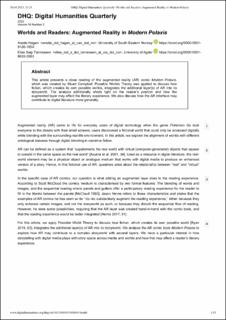| dc.contributor.author | Hagen, Anette | |
| dc.contributor.author | Tønnessen, Elise Seip | |
| dc.date.accessioned | 2023-05-16T09:22:10Z | |
| dc.date.available | 2023-05-16T09:22:10Z | |
| dc.date.created | 2022-05-13T08:47:46Z | |
| dc.date.issued | 2022 | |
| dc.identifier.citation | Hagen, A. & Tønnessen, E. S. (2022). Worlds and Readers: Augmented Reality in Modern Polaxis. Digital Humanities Quarterly, 16 (2), 1-15. | en_US |
| dc.identifier.issn | 1938-4122 | |
| dc.identifier.uri | https://hdl.handle.net/11250/3068160 | |
| dc.description.abstract | This article presents a close reading of the augmented reality (AR) comic Modern Polaxis,
which was created by Stuart Campbell. Possible Worlds Theory was applied to discuss how
fiction, which creates its own possible worlds, integrates the additional layer(s) of AR into its
storyworld. The analysis additionally sheds light on the reader’s position and how the
augmented layer may affect the literary experience. We also discuss how the AR interface may
contribute to digital literature more generally. | en_US |
| dc.language.iso | eng | en_US |
| dc.publisher | Alliance of Digital Humanities Organizations | en_US |
| dc.relation.uri | http://www.digitalhumanities.org/dhq/vol/16/2/000619/000619.html | |
| dc.rights | Attribution-NoDerivatives 4.0 Internasjonal | * |
| dc.rights.uri | http://creativecommons.org/licenses/by-nd/4.0/deed.no | * |
| dc.title | Worlds and Readers: Augmented Reality in Modern Polaxis | en_US |
| dc.type | Peer reviewed | en_US |
| dc.type | Journal article | en_US |
| dc.description.version | publishedVersion | en_US |
| dc.rights.holder | © 2022 The Author(s) | en_US |
| dc.subject.nsi | VDP::Humaniora: 000 | en_US |
| dc.source.pagenumber | 15 | en_US |
| dc.source.volume | 16 | en_US |
| dc.source.journal | Digital Humanities Quarterly | en_US |
| dc.source.issue | 2 | en_US |
| dc.identifier.cristin | 2024169 | |
| cristin.qualitycode | 1 | |

